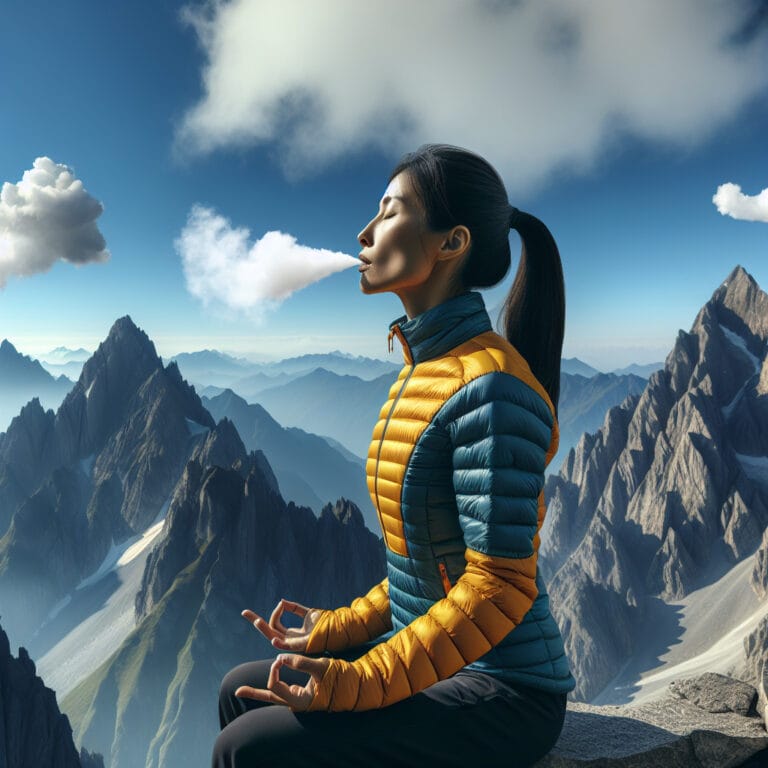
Mastering Breathing Exercises for High Altitude Acclimatization
Table of Contents
- Introduction
- Understanding the Science of High Altitude
- Breathing Techniques for High Altitude
- Practical Tips for High Altitude Acclimatization
- Conclusion
- Frequently Asked Questions
Introduction
It’s fascinating how our bodies respond to different environments and adapt accordingly. At sea level, the barometric pressure is high, and oxygen levels are sufficient to meet the metabolic needs of our body. Conversely, in higher altitudes where barometric pressure drops significantly and oxygen becomes scarce, our body increases its respiration rate as an immediate response, forcing our breathing muscles into overdrive. This natural reaction is an attempt to increase oxygen intake amid thinner air. However, this rapid breathing rate can often lead to altitude sickness if not managed correctly.
The importance of teaching your body proper breathing techniques for high altitude acclimatization cannot be overstated. Regular practice of specific exercises can strengthen your respiratory muscles and improve their efficiency even in lower oxygen levels. A popular method amongst athletes and rock climbers alike is the ‘box breathing technique.’ It involves inhaling slowly for a count of four, holding the breath for another count of four before exhaling equally slowly while counting up to four again – just like picturing a box’s sides.
Yoga too brings valuable tools into play when preparing for life at higher elevations. Its pose library poses (asanas) that benefit yoga practitioners by expanding lung capacity and building stamina overtime while enhancing overall vitality- attributes crucial in combating any kind of physical stress including those encountered at high altitudes.
Meditation practices with guided focus on slow deep breaths also serve as effective simulated altitude training – helping your body get accustomed to prolonged periods with reduced oxygen supply without triggering panic or discomfort.
Likewise, specialized respiratory muscle training using various types of yoga sequences can aid your journey towards acclimatizing efficiently at elevated regions without compromising health or performance.
However, it’s important that anyone planning such adventures – beginners or experienced athletes alike – seek advice from healthcare professionals or trained yoga teachers who understand underlying medical conditions one might have which could impact one’s ability to cope with drastic changes in environmental pressures.
In essence, consciously training your breath to adapt to high altitude conditions can minimize potential health risks and enhance the overall experience of exploring life beyond conventional sea level.
Understanding the Science of High Altitude
At high altitudes, the barometric pressure plummets and oxygen becomes a scarce resource. Your body responds instinctively to this change, cranking up its respiration rate in an attempt to draw in more oxygen from the thinner air. This automatic increase in respiration can put your respiratory muscles into overdrive, potentially leading to altitude sickness if not managed appropriately. As such, integrating breathing techniques into your preparation for high altitude activities can significantly enhance your body’s adaptability and performance.
One of the most effective techniques is box breathing—a popular method used by athletes and rock climbers alike—where you inhale slowly for four counts, hold the breath for another four counts before exhaling evenly for another four counts. This technique trains your respiratory muscles to work efficiently even in lower oxygen levels, reducing the risk of potential health complications like altitude sickness.
Yoga also offers valuable breathing exercises that can help prepare you better for higher altitudes. Regular practice of specific yoga poses from the pose library will strengthen your respiratory muscles while expanding lung capacity at the same time – key factors in facing physical stress caused by drastic environmental changes. These benefits extend beyond just anatomical improvements; yoga sequences guided by skilled yoga teachers also provide substantial spiritual upliftment—adding a unique dimension to handling high-altitude challenges.
Incorporating meditation practices that focus on slow deep breaths can serve as simulated altitude training too—helping you get accustomed to prolonged periods with reduced oxygen supply without triggering panic or discomfort.
However, always remember that everyone’s body reacts differently at high elevities—it’s not uncommon that even seasoned athletes might struggle with acclimatization due to underlying medical conditions they might have prior embarking on their adventure at elevated regions. Thus seeking professional advice from healthcare professionals or experienced yoga instructors is crucial before engaging in any rigorous activity at great heights.
To sum up: learning how to breathe correctly when you’re miles above sea level isn’t just for rock climbers or athletes – it’s a vital skill anyone heading towards the mountains needs. The right breathing exercises can help you acclimate more easily to high altitudes, reducing the risk of altitude sickness and enhancing your overall experience in these breathtaking environments. So, whether you’re planning a mountain hike, skiing trip or simply wishing to thrive at higher altitudes—don’t forget to take a deep breath.
| Fact | Description |
|---|---|
| Altitude effect on body | At high altitudes, the barometric pressure drops and oxygen becomes scarce. The body responds by increasing respiration rate, which can lead to altitude sickness if not managed well. |
| Box Breathing | A technique where you inhale slowly for four counts, hold the breath for another four counts before exhaling evenly for another four counts. It trains the respiratory muscles to work efficiently in lower oxygen levels. |
| Benefits of Yoga | Yoga offers valuable breathing exercises and specific poses that strengthen respiratory muscles and expand lung capacity. It also provides spiritual upliftment, adding a unique dimension to handling high-altitude challenges. |
| Meditation Practices | Meditation practices that focus on slow deep breaths can serve as simulated altitude training, helping you get accustomed to reduced oxygen supply without triggering panic or discomfort. |
| Individual Variation | Everyone’s body reacts differently at high altitudes. Even seasoned athletes might struggle with acclimatization due to underlying medical conditions. Professional advice from healthcare professionals or experienced yoga instructors is crucial. |
| Importance of Correct Breathing | Learning how to breathe correctly at high altitudes is a vital skill anyone heading towards the mountains needs. The right breathing exercises can help acclimate more easily to high altitudes, reducing the risk of altitude sickness and enhancing the overall experience. |
Breathing Techniques for High Altitude
Have you ever wondered about the intricate function of your breathing muscles when battling against the thin air at high altitudes? Breathing is not just an unconscious process but a mechanism that can be harnessed to maximize performance and health, especially when faced with challenging environments like elevated terrains. The secret lies in diaphragmatic breathing—a technique often emphasized by yoga teachers during yoga teacher training. By focusing on engaging your diaphragm while inhaling, this technique encourages deeper breaths and optimum use of the respiratory system—crucial for acclimatizing to higher altitudes where oxygen levels drop significantly.
Amidst the rocky peaks or steep slopes of rock climbing adventures, mastering effective breathing exercises becomes critical. Take the pursed-lip breathing technique as an example; it involves exhaling slowly through tightly pursed lips following a deep inhalation. This simple, yet powerful method aids in controlling one’s respiration rate, reducing rapid breathlessness caused by altitude sickness frequently encountered in such strenuous activities.
On par with these techniques is the box breathing exercise—an ancient practice widely employed by athletes and climbers alike to adapt their bodies to lower oxygen levels typical at high altitudes. Imagine four sides of a box while executing this method: each side representing an aspect of one’s breath cycle—inhalation, hold, exhalation, and another hold—all performed over slow counts of four. With consistent practice of this box breathing technique under guidance from competent professionals or yoga tools available online—one can fortify their respiratory muscle training even when separated from sea level comforts.
Yet another potent ally for battling thinner air is the 4-7-8 breathing technique—a style benefitting both beginners and experienced adventurers journeying towards higher elevations. Known for its calming effect on one’s nervous system aside from enhancing lung capacity—it involves inhaling for four counts, holding your breath for seven counts before exhaling audibly over eight counts. It’s a type of yoga pose for the respiratory system—used by many to harmonize their breathing rate with the rhythm of nature even amidst reduced barometric pressure.
Such practices are not just about anatomy or targeted muscle training—they encompass a spiritual dimension too. Delving into meditation guided by the resonance of yoga music can be transformative—helping you meditate deeper and longer, simulating altitude conditions at peace within your own space. This fosters emotional resilience—an unspoken yet essential requirement when addressing high-altitude challenges.
In this journey towards acclimatizing oneself to high altitudes, remember that everyone’s body varies in its response to environmental shifts. Even seasoned athletes might experience struggles due to underlying medical conditions. So, consulting a healthcare professional before implementing any breathing exercises is always recommended. After all, it’s not just about scaling heights—it’s about doing so with mindfulness and respect for one’s health and limits: a testament to true victory over thin air.
| Technique | Description | Benefits |
|---|---|---|
| Diaphragmatic Breathing | Focus on engaging your diaphragm while inhaling. Encourages deeper breaths and optimum use of the respiratory system. | Crucial for acclimatizing to higher altitudes where oxygen levels drop significantly. |
| Pursed-lip Breathing | Exhaling slowly through tightly pursed lips following a deep inhalation. | Helps in controlling one’s respiration rate, reducing rapid breathlessness caused by altitude sickness. |
| Box Breathing | Imagine four sides of a box representing each aspect of one’s breath cycle—inhalation, hold, exhalitation, and another hold—all performed over slow counts of four. | Adapts bodies to lower oxygen levels typical at high altitudes. Fortifies respiratory muscle training. |
| 4-7-8 Breathing | Involves inhaling for four counts, holding your breath for seven counts before exhaling audibly over eight counts. | Calms one’s nervous system, enhances lung capacity, and harmonizes breathing rate with the rhythm of nature. |
| Meditation | Delving into meditation guided by the resonance of yoga music. | Helps to meditate deeper and longer, simulating altitude conditions, and fosters emotional resilience. |
Practical Tips for High Altitude Acclimatization
The art of breathing at high altitudes is much like a delicate dance between one’s body and the thin air surrounding it. Each inhalation becomes a strategic move, aiming to maximize oxygen uptake in an environment where every breath counts. This may seem daunting, especially for beginners venturing into rock climbing or high-altitude treks for the first time. But with consistent practice of breathing exercises and guided yoga sequences, the body gradually learns how to optimally utilize its respiratory muscles amidst lower oxygen levels.
One key aspect that often gets overlooked during such preparations is the importance of gradual ascent in acclimatization process. Just as yoga teachers emphasize on steadily progressing through pose library poses during yoga teacher training, your journey towards higher altitudes too needs to be approached with patience. Rushing up could lead to altitude sickness – a condition triggered when your respiration rate drastically spikes trying to compensate for reduced barometric pressure at elevations far from sea level comforts.
Physical fitness though paramount doesn’t guarantee immunity against such risks; even seasoned athletes might face struggles due to their unique anatomy or underlying medical conditions. However, resilience can be built over time by incorporating simulated altitude training regularly—enhancing one’s ability to withstand physical stress caused by thinner air while minimizing discomfort.
Hydration and nutrition also play crucial roles here—they act as fuel supporting this intricate dance your body performs with each breath taken at elevated regions. Adequate water intake aids in maintaining steady respiration rates and helps prevent dehydration—a common issue faced when living amidst dry mountain air devoid of usual humidity found closer to sea level.
In addition, consuming nutrient-dense meals rich in complex carbohydrates will supply much-needed energy empowering you during physically demanding activities like rock climbing or long hikes over rugged terrains; ensuring that your body doesn’t run out of fuel prematurely before reaching desired heights.
Lastly, remember that embracing practices like meditation can provide immense benefit beyond just physiological adaptations—it equips you spiritually too, fostering emotional resilience and enhancing overall well-being. As much as high-altitude adventures challenge one’s physical limits, they also offer humbling reminders about our connection with nature—meditating to the rhythm of breaths taken in harmony with the surrounding mountains can be a transformative experience; making each ascent feel less like a battle against thin air and more like a harmonious dance with it.
While this journey towards acclimatization is unique to each individual depending on their anatomy, underlying medical conditions or fitness levels; everyone shares one common tool—their breath. Learning how to harness it effectively through various breathing techniques will not only aid in thriving at higher altitudes but also enrich your understanding of self and life beyond sea level.
Conclusion
Harnessing the power of breathing at high altitudes is a delicate balance between physiology and endurance. The body’s interaction with thinner air necessitates a strategic control over every inhalation and exhalation to maximize oxygen uptake, making each breath an opportunity for performance enhancement. At elevated regions, barometric pressure decreases significantly, causing your respiration rate to increase as the body attempts to draw more oxygen from its surroundings. This automatic response can lead to altitude sickness if not appropriately controlled through effective breathing exercises. Known methods like box breathing technique, where each aspect of the breath cycle—inhaling, holding, exhaling and pausing—is executed deliberately over slow counts of four; have proven benefits in fortifying respiratory muscle training against lower oxygen levels typical at higher altitudes. As our bodies ascend from sea level towards lofty peaks or rock climbing adventures, gradual acclimatization can help mitigate physical stress caused by environmental changes. This includes simulated altitude practices that focus on slow deep breaths which aid in expanding lung capacity while calming the nervous system—a style benefit yoga practitioners both beginners and athletes alike find particularly beneficial during their energetics journey amidst nature’s wild heights. Alongside this physiological adaptation lies an equally important mental readiness—meditation guided by soothing yoga music or other yoga tools available online allows one to introspect on their anatomy pose finder practice while fostering emotional resilience crucial for facing underlying medical conditions or unexpected struggles during high-altitude explorations; redefining victories not just by how far you climb but also how well you breathe along the way.



